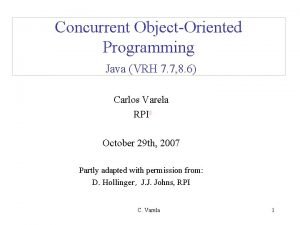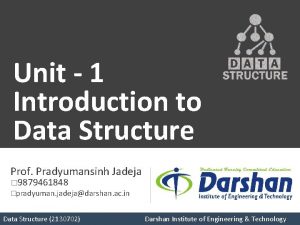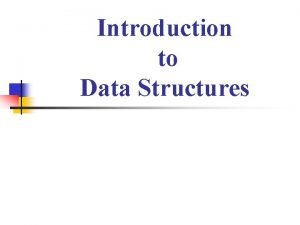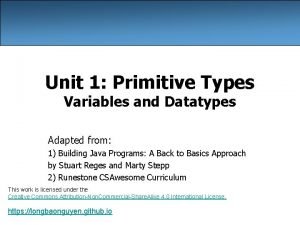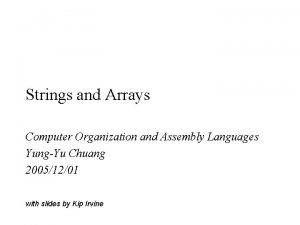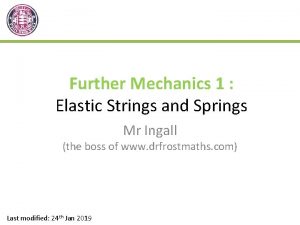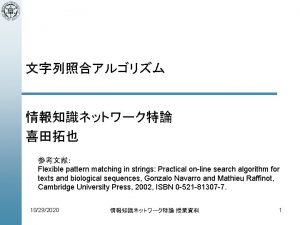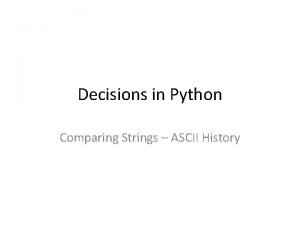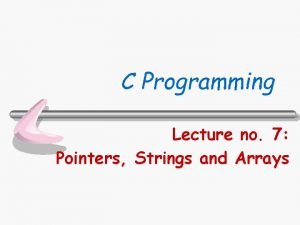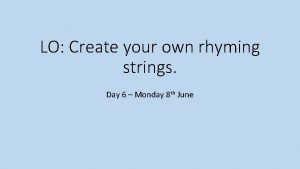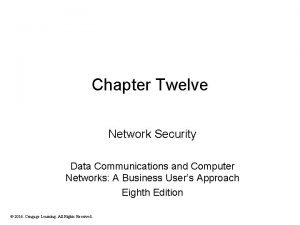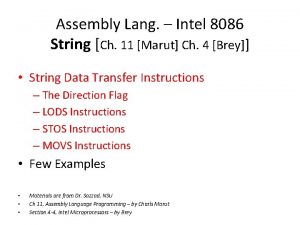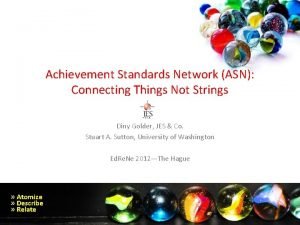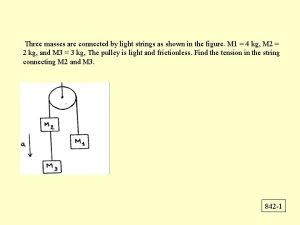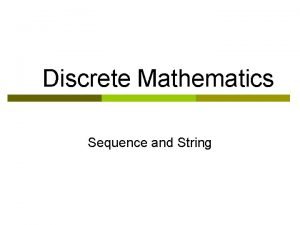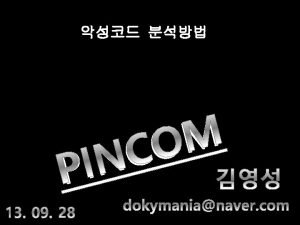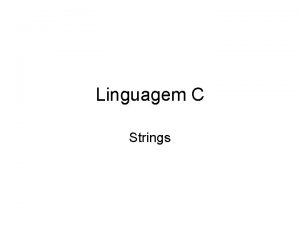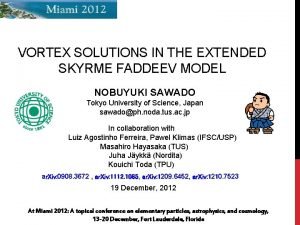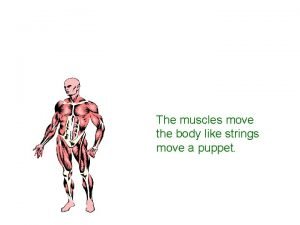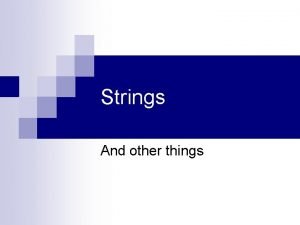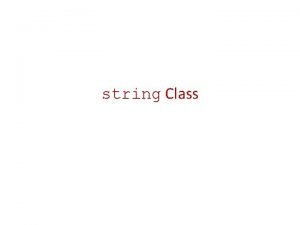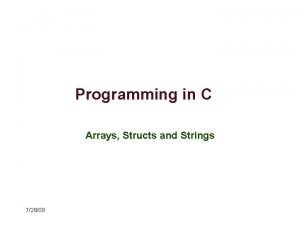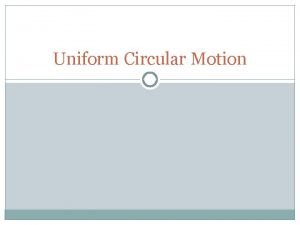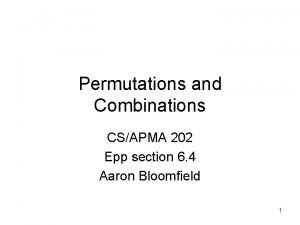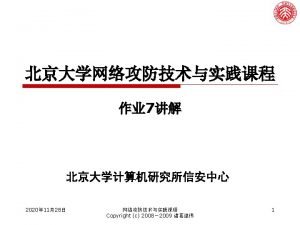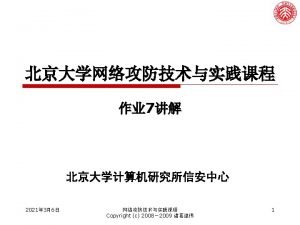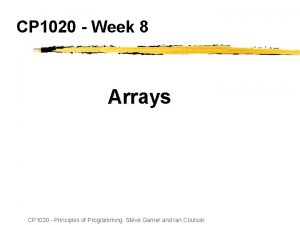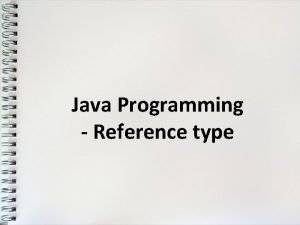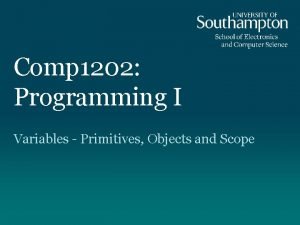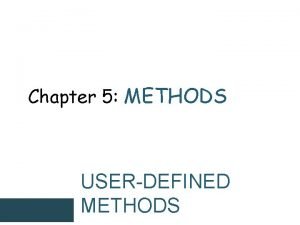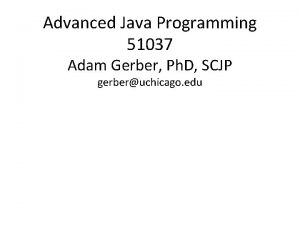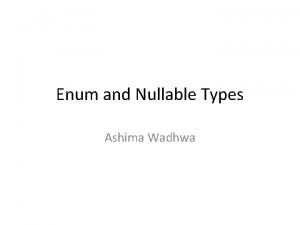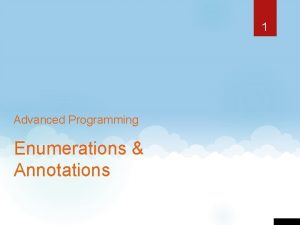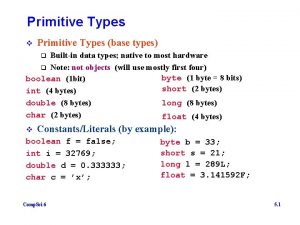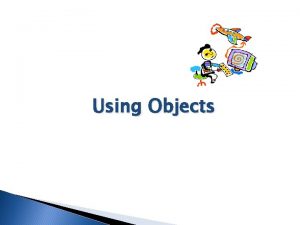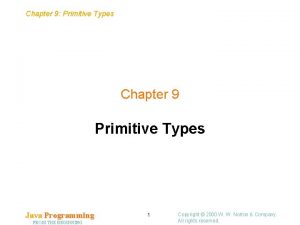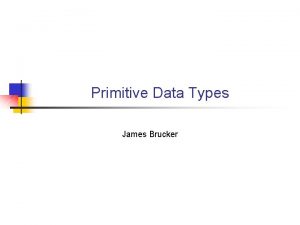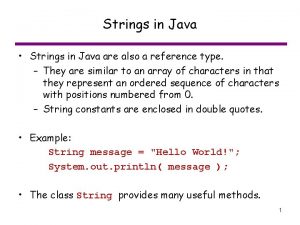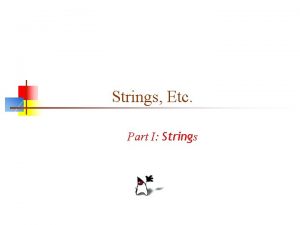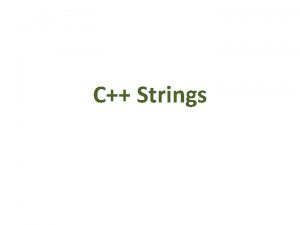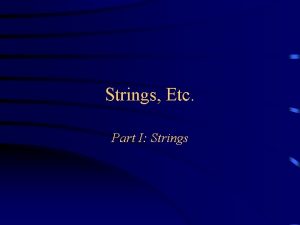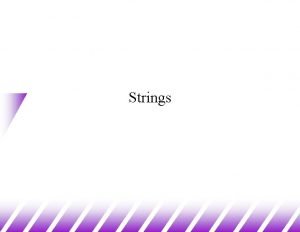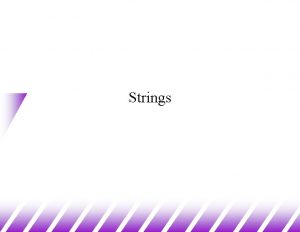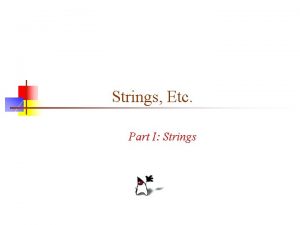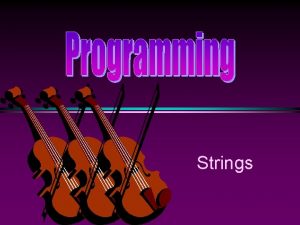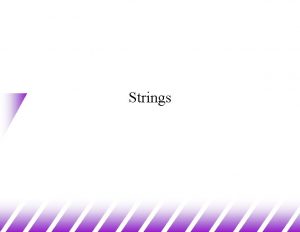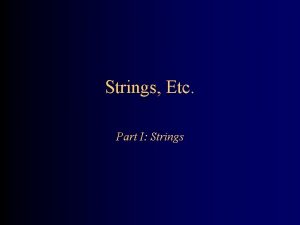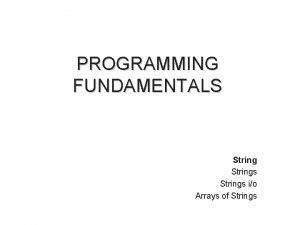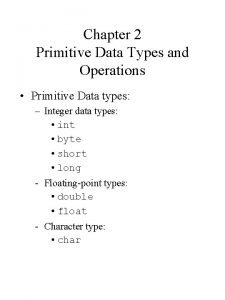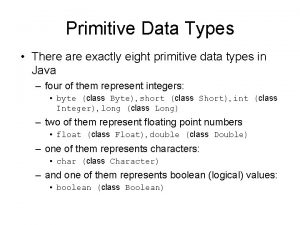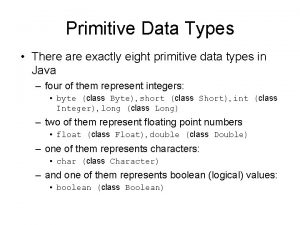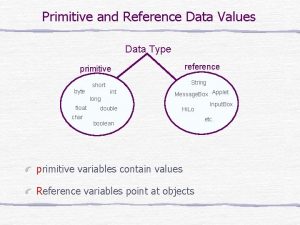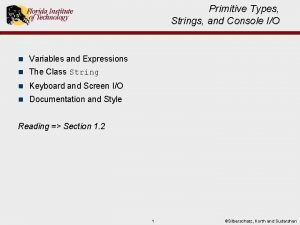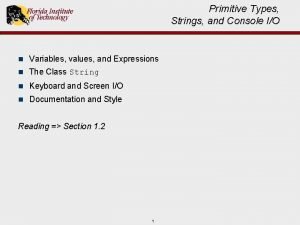Primitive Types Vs Reference Types Strings Enumerations Java







































- Slides: 39

Primitive Types Vs. Reference Types, Strings, Enumerations Java How to Program, 10/e Late Objects Version © Copyright 1992 -2015 by Pearson Education, Inc. All Rights Reserved.

References & Reading The content is mainly selected (sometimes modified) from the original slides provided by the authors of the textbook Readings § Chapter 6: Arrays and Array. Lists § Chapter 14: Strings, Characters and Regular Expressions § Introduction to Enumerations (CMSC 202, University of Maryland, Baltimore County) https: //www. csee. umbc. edu/courses/undergraduate/202/spring 13/l ectures/enums. pdf © 1992 -2015 by Pearson Education, Inc. All Rights Reserved.

Outline 6. 2 Primitive Types vs. Reference Types -. - Introduction to Objects 14. 1 Introduction 14. 2 Fundamentals of Characters and Strings 14. 3 Class String 14. 3. 1 String Constructors 14. 3. 2 String Methods length, char. At and get. Chars 14. 3. 3 Comparing Strings 14. 3. 4 Locating Characters and Substrings in Strings © 1992 -2015 by Pearson Education, Inc. All Rights Reserved.

Outline 14. 3. 5 Extracting Substrings from Strings 14. 3. 6 Concatenating Strings 14. 3. 7 Miscellaneous String Methods -. - Introduction to Enumerations (from CMSC 202) © 1992 -2015 by Pearson Education, Inc. All Rights Reserved.

6. 2 Primitive Types vs. Reference Types Java’s types are divided into primitive types and reference types. Primitive types: boolean, byte, char, short, int, long, float and double. § Appendix D lists the eight primitive types in Java. All nonprimitive types are reference types. © 1992 -2015 by Pearson Education, Inc. All Rights Reserved.

6. 2 Primitive Types vs. Reference Types (cont. ) A primitive-type variable can hold exactly one value of its declared type at a time. Programs use variables of reference types (normally called references) to store the addresses of objects in the computer’s memory. § Such a variable is said to refer to an object in the program. To call an object’s methods, you need a reference to the object. If an object’s method requires additional data to perform its task, then you’d pass arguments in the method call. Primitive-type variables do not refer to objects, so such variables cannot be used to invoke methods. © 1992 -2015 by Pearson Education, Inc. All Rights Reserved.

-. - Introduction to Objects Class: is reference type § String, System, Scanner, Math, Secure. Random Object: is a reference or object (variable of type class) § String s; Scanner input; Secure. Random sr; Class Method: called using the class name § Math. pow(x, y); Object Methods: called using the object § input. next. Int(); Static fields: class field (belong to the class, common to all objects) Fields: object filed (specific to a particular object) © Copyright 1992 -2015 by Pearson Education, Inc. All Rights Reserved.

14. 1 Introduction The foundation for string and character manipulation in Java is provided by three classes § class String, § class String. Builder and § class Character from the java. lang package. We’ll only study the usage of the class String © Copyright 1992 -2015 by Pearson Education, Inc. All Rights Reserved.

14. 2 Fundamentals of Characters and Strings A program may contain character literals. § An integer value represented as a character in single quotes. § The value of a character literal is the integer value of the character in the Unicode character set. String literals (stored in memory as String objects) are written as a sequence of characters in double quotation marks. © Copyright 1992 -2015 by Pearson Education, Inc. All Rights Reserved.

© Copyright 1992 -2015 by Pearson Education, Inc. All Rights Reserved.

14. 3 Class String is used to represent strings in Java. The next several subsections cover many of class String’s capabilities. We’ll create strings using different versions of the String constructor A constructor is an object method called when declaring an object © Copyright 1992 -2015 by Pearson Education, Inc. All Rights Reserved.

14. 3. 1 String Constructors Create an empty string represented as "" and has a length of 0. § String s 1 = new String(); Constructor that takes a String object copies the argument into the new String. § String str = "Hello"; § String s = new String("Hello"); § String s 2 = new String(s 2); Constructor that takes a char array creates a String containing a copy of the characters in the array. Constructor that takes a char array and two integers creates a String containing the specified portion of the array. © Copyright 1992 -2015 by Pearson Education, Inc. All Rights Reserved.

© Copyright 1992 -2015 by Pearson Education, Inc. All Rights Reserved.

14. 3. 2 String Methods length, char. At and get. Chars String method length determines the number of characters in a string. String method char. At returns the character at a specific position in the String method get. Chars copies the characters of a String into a character array. § The first argument is the starting index in the String from which characters are to be copied. § The second argument is the index that is one past the last character to be copied from the String. § The third argument is the character array into which the characters are to be copied. § The last argument is the starting index where the copied characters are placed in the target character array. © Copyright 1992 -2015 by Pearson Education, Inc. All Rights Reserved.

© Copyright 1992 -2015 by Pearson Education, Inc. All Rights Reserved.

© Copyright 1992 -2015 by Pearson Education, Inc. All Rights Reserved.

14. 3. 3 Comparing Strings are compared using the numeric codes of the characters in the strings. © Copyright 1992 -2015 by Pearson Education, Inc. All Rights Reserved.

© Copyright 1992 -2015 by Pearson Education, Inc. All Rights Reserved.

© Copyright 1992 -2015 by Pearson Education, Inc. All Rights Reserved.

© Copyright 1992 -2015 by Pearson Education, Inc. All Rights Reserved.

14. 3. 3 Comparing Strings (cont. ) Method equals tests any two objects for equality § The method returns true if the contents of the objects are equal, and false otherwise. § Uses a lexicographical comparison. When primitive-type values are compared with ==, the result is true if both values are identical. When references are compared with ==, the result is true if both references refer to the same object in memory. Java treats all string literal objects with the same contents as one String object to which there can be many references. © Copyright 1992 -2015 by Pearson Education, Inc. All Rights Reserved.

14. 3. 3 Comparing Strings (cont. ) String method equals. Ignore. Case ignores whether the letters in each String are uppercase or lowercase when performing the comparison. Method compare. To is declared in the Comparable interface and implemented in the String class. § Returns 0 if the Strings are equal, a negative number if the String that invokes compare. To is less than the String that is passed as an argument and a positive number if the String that invokes compare. To is greater than the String that is passed as an argument. © Copyright 1992 -2015 by Pearson Education, Inc. All Rights Reserved.

14. 3. 3 Comparing Strings (cont. ) Method region. Matches compares portions of two Strings for equality. § The first argument to this version of the method is the starting index in the String that invokes the method. § The second argument is a comparison String. § The third argument is the starting index in the comparison String. § The last argument is the number of characters to compare. Five-argument version of method region. Matches: § When the first argument is true, the method ignores the case of the characters being compared. § The remaining arguments are identical to those described for the four -argument region. Matches method. © Copyright 1992 -2015 by Pearson Education, Inc. All Rights Reserved.

14. 3. 3 Comparing Strings (cont. ) String methods starts. With and ends. With determine whether strings start with or end with a particular set of characters © Copyright 1992 -2015 by Pearson Education, Inc. All Rights Reserved.

© Copyright 1992 -2015 by Pearson Education, Inc. All Rights Reserved.

14. 3. 4 Locating Characters and Substrings in Strings © Copyright 1992 -2015 by Pearson Education, Inc. All Rights Reserved.

© Copyright 1992 -2015 by Pearson Education, Inc. All Rights Reserved.

© Copyright 1992 -2015 by Pearson Education, Inc. All Rights Reserved.

14. 3. 4 Locating Characters and Substrings in Strings (cont. ) Method index. Of locates the first occurrence of a character in a String. If the method finds the character, it returns the character’s index in the String—otherwise, it returns – 1. A second version of index. Of takes two integer arguments—the character and the starting index at which the search of the String should begin. Method last. Index. Of locates the last occurrence of a character in a String. The method searches from the end of the String toward the beginning. If it finds the character, it returns the character’s index in the String—otherwise, it returns – 1. A second version of last. Index. Of takes two integer arguments—the integer representation of the character and the index from which to begin searching backward. There also versions of these methods that search for substrings in Strings. © Copyright 1992 -2015 by Pearson Education, Inc. All Rights Reserved.

14. 3. 5 Extracting Substrings from Strings Class String provides two substring methods to enable a new String object to be created by copying part of an existing String object. Each method returns a new String object. The version that takes one integer argument specifies the starting index in the original String from which characters are to be copied. The version that takes two integer arguments receives the starting index from which to copy characters in the original String and the index one beyond the last character to copy. © Copyright 1992 -2015 by Pearson Education, Inc. All Rights Reserved.

© Copyright 1992 -2015 by Pearson Education, Inc. All Rights Reserved.

14. 3. 6 Concatenating Strings String method concatenates two String objects (similar to using the + operator) and returns a new String object containing the characters from both original Strings. The original Strings to which s 1 and s 2 refer are not modified. © Copyright 1992 -2015 by Pearson Education, Inc. All Rights Reserved.

© Copyright 1992 -2015 by Pearson Education, Inc. All Rights Reserved.

14. 3. 7 Miscellaneous String Methods © Copyright 1992 -2015 by Pearson Education, Inc. All Rights Reserved.

© Copyright 1992 -2015 by Pearson Education, Inc. All Rights Reserved.

-. - Introduction to Enumerations Enumerated values are used to represent a set of named values. Historically in Java (and other languages), these were often stored as constants. For example, in Java. . . public static final int int NORTH = 0; EAST = 1; SOUTH = 2; WEST = 3; © 1992 -2015 by Pearson Education, Inc. All Rights Reserved.

-. - Introduction to Enumerations (cont. ) There are several issues with this approach. § § Acceptable values are not obvious No type safety No name-spacing Not printable Eums address these issues (Java 5). § Declared using the enum keyword instead of class § In its simplest form, it contains a comma-separated list of names representing each of the possible options. public enum Direction { NORTH, EAST, SOUTH, WEST } © 1992 -2015 by Pearson Education, Inc. All Rights Reserved.

-. - Introduction to Enumerations (cont. ) Additional Benefits of enums. § Storage of additional information enums are objects § Retrieval of all enumerated values of a type: Direction[ ] directions = Direction. values(); § Comparison of enumerated values if(suit == Suit. CLUBS) { // do something } © 1992 -2015 by Pearson Education, Inc. All Rights Reserved.

-. - Introduction to Enumerations (cont. ) Enums can also be used with the switch control structure. Direction dir = /*. . . */; switch (dir) { case EAST: case WEST: // do something break; case NORTH: case SOUTH: // do something else break; default: // yet another thing break; } © 1992 -2015 by Pearson Education, Inc. All Rights Reserved.
 Primitive vs reference types java
Primitive vs reference types java Data structure classification
Data structure classification Introduction to data structure
Introduction to data structure Strings in java
Strings in java Unit 1 primitive types
Unit 1 primitive types Reference node and non reference node
Reference node and non reference node Reference node and non reference node
Reference node and non reference node Array of strings assembly
Array of strings assembly Tension in elastic string
Tension in elastic string Image search reverse
Image search reverse Rate of energy transfer by sinusoidal waves on strings
Rate of energy transfer by sinusoidal waves on strings Compare strings python
Compare strings python Pointers and strings
Pointers and strings A long bamboo nose flute among the bontocs
A long bamboo nose flute among the bontocs Mason nagy
Mason nagy Mrs sprockett's strange machine
Mrs sprockett's strange machine A type of cipher that uses multiple alphabetic strings
A type of cipher that uses multiple alphabetic strings Cld instruction in 8086
Cld instruction in 8086 Things not strings
Things not strings Three masses are connected by strings
Three masses are connected by strings Sequences in discrete mathematics
Sequences in discrete mathematics Sysinternals strings
Sysinternals strings String c language
String c language Vortex strings
Vortex strings Lflexion
Lflexion String and other things
String and other things C string class
C string class What is string in c
What is string in c Jmp concatenate strings
Jmp concatenate strings E you
E you Ottawa suzuki strings
Ottawa suzuki strings Combination or permutation
Combination or permutation Ida pro strings
Ida pro strings Ida strings
Ida strings Declare a two dimensional array of strings named chessboard
Declare a two dimensional array of strings named chessboard Java reference
Java reference Java reference
Java reference Reference variable in java
Reference variable in java Java method reference
Java method reference Import java.util.scanner;
Import java.util.scanner;
